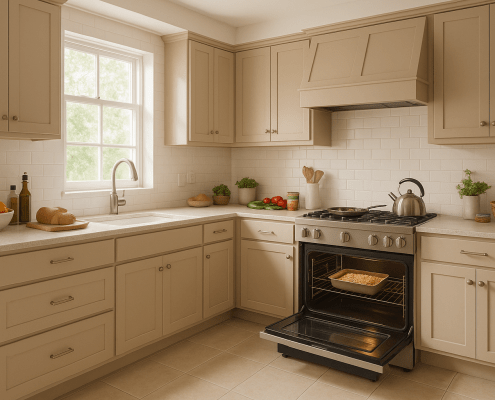Troubleshooting Samsung Electric Range Oven Heating Problems
Steven E / Friday May 23, 2025
Your Samsung electric range oven isn’t heating like it should, so what’s going on? We’ll break down the cause and show you how to fix it yourself before calling a repair service.
If you need any replacement parts for your Samsung range, you can enter your model number at AppliancePartsPros.com to order them. Most orders arrive in just two business days, and we have thousands of free guides to show you how to install your new parts.
The information in this article may not apply to your specific appliance model. We recommend consulting your manufacturer’s documentation or contact us with any questions.
What you need
- Multimeter
- Phillips head screwdriver
- Flat-head screwdriver
Safety precautions
When working on any appliance, always keep safety first to avoid personal injury or damage to the appliance or its parts. Here are some tips to keep in mind:
- Always power off and unplug your appliance or switch off the circuit breaker before you attempt any maintenance or replacement work. This keeps you safe by eliminating any risk of electric shock.
- If the appliance has recently been used, give it plenty of time to cool down before working on it.
- Take your time while working to prevent accidents and personal injuries. Rushing is the enemy of precision.
- Work in a well-lit area so you can see and access appliance parts.
- Keep your workspace free of clutter and other obstacles. Keep children and pets away from the work area.
- Never work on internal parts with wet hands. Make sure the work area is completely dry.
- Check the user manual to see if there are specific installation or safety instructions related to your appliance or replacement part.
- Be gentle when handling or removing parts. Excessive force might damage the appliance or cause personal injury.
- Wear insulated work gloves to protect your hands from sharp metal parts and debris.
- When working with wires, avoid touching any exposed wires or terminals. If you need to touch a wire, use a non-conductive tool or wear insulating gloves to prevent electrical shock.
- Always take photos or make a note of wiring terminals or other connections before disconnecting them to make reassembly easier.
- Don’t test live voltage with a multimeter if you’re unfamiliar with how to prevent short-circuiting.
- Consider wearing safety glasses and/or a dust mask when working with chemicals, dust or a large amount of debris to prevent irritation or injury.
How to fix oven heating issues on a Samsung electric range
Below are the steps to diagnose and repair heating issues in a Samsung electric range, including testing the temperature sensor, control board, heating elements, and wiring.
Step 1. Test the oven temperature sensor
- Turn the oven off and pull the range away from the wall.
- Remove the Phillips head screws from the back panel.
- Locate the temperature sensor probe connector on the right side.
- Disconnect the connector and use a multimeter set to Ohms.
- Test the probe side of the connector; it should read approximately 1080 Ohms at room temperature (72°F), with a 10% variance.
- If the reading is out of range, replace the sensor. If it is correct, move on to the next test.
NOTE: Generally, for every 1 degree in temperature difference, 2 Ohms could be added or subtracted. If the temperature in your home is cooler, resistance would be subtracted.
Step 2. Test the oven control board
LIVE VOLTAGE WARNING: For this test, the appliance needs to be plugged in and powered on. Please be very careful to protect yourself from electric shock, which has the potential to cause serious injuries. Don’t ever test live voltage if you’re uncomfortable using a multimeter.
- Remove the rear panel using a Phillips head screwdriver.
- Locate the main control board.
- Set the multimeter to AC voltage.
- Turn the oven on to bake.
- Place one lead on the T501 terminal and the other lead on the black wire at the CN101 connection.
- A reading of 240 VAC confirms proper input voltage.
- To check output voltage, set the control to bake and test between T501 and T505; it should read 240 VAC.
- Turn off the bake and turn on the broil. Test between T501 and T503; it should read 240 VAC.
- Turn off the broil and turn on the convection bake. Test between T501 and T507; it should read 240 VAC.
- If any output voltage is incorrect, replace the control board. If all readings are correct, check the elements or wiring.
Step 3. Test the bake element
- Turn off the power or unplug the unit.
- Remove the Phillips head screws from the back panel.
- Locate the bake element at the bottom of the oven (hidden from view).
- Restore power and turn the oven on to bake.
- Set the multimeter to AC voltage and test across the two terminals without disconnecting the wires.
- If the reading is 240 VAC but the element does not heat, replace the element.
- If the voltage is incorrect, check for burned or damaged wiring. If the wiring is intact, replace the control board.
Step 4. Test the broil element
- Turn off the power or unplug the unit.
- Remove the rear panel screws and locate the broil element (midway up the back).
- Restore power and turn the oven on to broil.
- Set the multimeter to AC voltage and test across the two terminals.
- If the reading is 240 VAC but the element does not heat, replace the element.
- If the voltage is incorrect, check the wiring for damage. If the wiring is intact, replace the control board.
Step 5. Test the convection heat element
- Unplug the range or turn off the breaker.
- Pull the range out and remove the rear panel screws.
- Locate the convection heater terminals and disconnect both connectors.
- Restore power and set the oven to convection bake.
- Set the multimeter to AC voltage and test the voltage at the plugs. It should read 240 VAC.
- If voltage is present but the heater does not work, replace the element.
- If no voltage is detected, inspect the wiring for damage. If the wiring is intact, replace the control board.
- To check resistance, set the multimeter to Ohms and test across the two terminals. The reading should be approximately 70-73 Ohms.
Step 6. Check for wiring damage
- Unplug the range or turn off the breaker.
- Pull the range out and remove the rear panel screws.
- Inspect the wires, especially around the terminal block, for burns, breaks, or loose connections.
- If wires are burned or broken, repair or replace them.
- If the terminal block is damaged, replace it.
- If the wiring is damaged beyond repair, replace the wire harness.
Step 7. Find the cause of the heating issue
- If a broken wire is found, repair or replace it and test the oven.
- If the oven heats slowly or does not maintain temperature despite all components testing correctly, replace the control board.
- If an element does not heat but receives 240 VAC, replace the element.
- Follow the process of elimination to identify the faulty component.
Step 8. Replace a faulty broil element
- Turn off the breaker or unplug the range.
- Remove the oven door by opening it fully and pulling out the door catch clips. Lift the door up and out.
- Remove the oven racks for easier access.
- Remove the rear panel screws and set the panel aside.
- Locate the broil element and disconnect the wires from its terminals.
- From the front, remove the four screws securing the element and take it out.
- Install the new broil element in place and secure it with four screws.
- Reconnect the wires to the terminals.
- Reattach the back panel, reinstall the oven racks, and position the door properly.
Step 9. Restore power and test the repair
- Turn the power back on or plug the range in.
- Set the oven to broil and observe its operation.
- A slight odor may be present initially, which is normal.
- Confirm that the oven is heating correctly and that the repair is successful.
Stick with us
Thanks for sticking with us! We hope this guide got your Samsung electric range back up and running. If you’ve got other appliance repairs on your list, take a look at our other guides and videos for some more help. When you’re ready to order new parts, just grab your model number and head over to AppliancePartsPros.com. You can chat with a pro, check out our DIY blog, view diagrams and more. Don’t forget to subscribe on YouTube and connect with us on Facebook, X and Instagram!
With nearly a decade of experience in providing top-notch customer service regarding appliance parts and repair, Steven enjoys sharing practical advice, troubleshooting tips, and interesting information to help readers stay informed.





